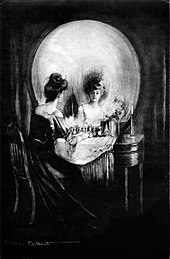Picture puzzle

A picture-puzzle ( latin vexare 'plague ) is, according to Dictionary of Grimm a "was taken using a hidden in the drawing, farce".
history

In the late Middle Ages, picture puzzles were, similar to so-called song puzzles, a way for draftsmen to point out a grievance or to depict a satirical exaggeration in drawings without having to fear immediate punishment. In this sense, however, the picture puzzles also often served for amusement, as one could perceive a different meaning of what was drawn by turning, etc. Franz Kafka is quoted from his diary entry from 1911: “'What is hidden in a picture puzzle' is 'clear and invisible': clear for those who have found what they were asked to look at; invisible to those who do not even know that there is something to be looked for. ”In other languages (English, French), picture puzzle is simply equated with a puzzle or search picture.
species
- An apparently correctly constructed image , the object of which turns out to be impossible, such as B. the Penrose triangle . Such objects are called impossible figures .
- The anchor in Esbjerg's coat of arms is a search image that contains a figure that cannot be recognized at first glance .
- An image that, thanks to its special construction, conveys different image content from different perspectives.
- Anamorphosis is a special form of the picture puzzle .
See also
Web links
- Picture puzzles and charades. With typology and history of the picture puzzle
Individual evidence
- ↑ Picture puzzle. In: Jacob Grimm , Wilhelm Grimm (Hrsg.): German dictionary . tape 26 : Vesche – Vulkanisch - (XII, 2nd section). S. Hirzel, Leipzig 1951 ( woerterbuchnetz.de ).
- ↑ Ute Harbusch, Gregor Wittkop: Short stay: Forays through literary places . P. 271. books.google.de
- ^ Imtiaz H. Habib: Shakespeare's pluralistic concepts of character: a study in dramatic anamorphism . P. 27. books.google.de
- ↑ Verena von Nell: Corruption: interdisciplinary approaches to a complex phenomenon . S. 31. books.google.de ("Characteristic [...] are at least two picture objects [...] between which the viewer [...] can switch".)
